

| Home | Log In | Register | Our Services | My Account | Contact | Help |
You are NOT currently logged in
dai oldenrich - 01 Sep 2006 13:32
click your browser refresh button to update charts
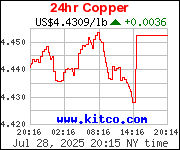
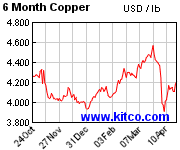
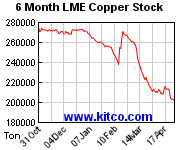
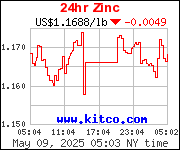
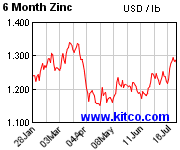
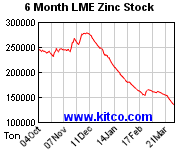
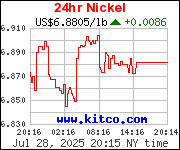
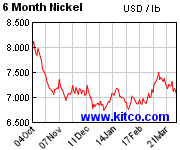
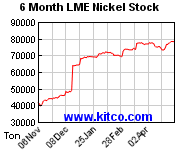
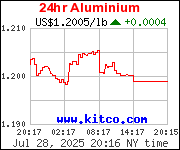
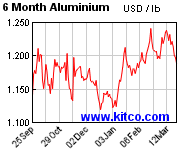
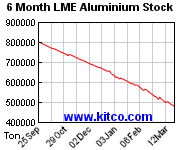
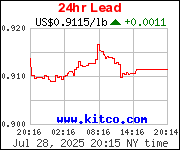
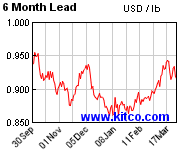
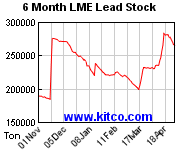
Also see: gold charts here silver charts here platinum charts here
dai oldenrich - 27 Oct 2006 08:13 - 147 of 181
Business Report - October 27, 2006
The commodity bull run is still in its early stages - By Bruce Tinney
The recent major themes of earnings growth, extraordinary cash flow and corporate activity should remain in place for the resources sector.
Strong, concerted growth in global industrial production has been the driving force behind the strength in commodity prices for the past three years.
Chinese industrial production, which grew at around 10 percent a year during the late 1990s, stepped up a gear to 20 percent. At the same time, Group of Seven (G7) industrial production recovered from the weakness in 2002, growing at an above-trend rate since 2004.
We are in the early stages of a long-term bull market for commodities, which should progress as Asia moves up the development curve. The per capita consumption of commodities for China and India is well below that of developed economies.
Recently, however, the G7 leading indicator has turned down, and globally we are now at the mature end of the current business cycle.
Historically, metal prices have declined when the US Federal Reserve stopped raising interest rates. Oil prices have already corrected, and base metals are expected to follow. It is interesting that the price:earnings ratio of BHP Billiton, the largest miner in the world, is 11.5 times.
This is the same rating on which the company traded at the start of this commodity cycle early in 2003. In other words, the market is rating the company as if this is the end of the cycle, and earnings have peaked. No recognition is being awarded for its extraordinary cash flows, management initiatives, portfolio positioning or project pipeline.
The surge in demand for commodities followed years of underinvestment in production capacity, consequently new supply has simply failed to meet demand, as evidenced by falling metal inventories.
The poor supply-side response is not a short-term phenomenon; as capital and operating costs are rising and quali- fied people are in short supply.
Consequently, a return to previous trough price levels for commodities is not anticipated and the major themes for the mining industry should remain in place. The rand will continue to weaken, acting as a hedge against any dollar commodity price weakness.
At the half-year, the resource companies reported year-on-year earnings growth in excess of 40 percent.
While earnings growth momentum for the diversified mining sector should peak in the first half of 2007, forward earnings growth for the platinum and gold producers could be substantial, even at lower metal prices, and forward price:earnings multiples are well below historical averages.
The feature of the mid-year reporting season was the high level of free cash flow, and resulting strength of the balance sheets for the resource firms.
Over the next 18 months, mining companies should continue to generate above-normal levels of discretionary cash flow at a time when balance sheets are relatively ungeared and mining projects are in short supply.
The excess cash should flow back to shareholders via lower dividend cover, share buy-backs, or special dividends.
The corporate activity stage of this economic cycle is under way, with some large deals, including CVRD's $15.16 billion (R114 billion) cash offer for Canadian mining house Inco.
In the absence of greenfields investments, there should be further consolidation of the industry.
Beneficiaries of corporate action could include Kumba, and some of the smaller platinum miners.
# Bruce Tinney is a resources analyst at BoE Private Clients
maddoctor - 27 Oct 2006 09:38 - 148 of 181
thanks once again dai for your thread
dai oldenrich - 28 Oct 2006 08:12 - 149 of 181
Glad to be of assistance maddoctor! Happy hunting!!
dai oldenrich - 28 Oct 2006 08:12 - 150 of 181
Oct. 27 (Bloomberg)
Copper May Decline Next Week; Supply Squeeze Eases - By Chanyaporn Chanjaroen
Copper may drop next week after increases in stockpiles worldwide eased a supply squeeze.
Inventory of the metal used in wires and pipes tracked by commodity exchanges in London, New York and Shanghai jumped to 187,079 metric tons, the highest in four weeks. Eight of 11 analysts, investors and traders surveyed by Bloomberg yesterday and Oct. 25 forecast copper will decline next week. Two expect a gain and one little change.
``With copper continuing to flow into the terminal markets, warehouses and domestic business, I'll go with `down,''' said Warren Gelman, president of St. Louis-based trading company Kataman Metals Inc.
Copper for delivery in three months on the London Metal Exchange rose $70, or 0.9 percent, to $7,520 a metric ton as of 11:47 a.m. local time. It has fallen 0.3 percent this week.
On the Comex division of the New York Mercantile Exchange, copper for December delivery gained 0.2 percent to $3.405 a pound in after-hours electronic trading. Copper for delivery in December on the Shanghai Futures Exchange fell 0.7 percent to close at 70,310 yuan ($8,912) a ton. Chinese prices include 17 percent tax and 2 percent duty.
The extra cost of buying copper for immediate delivery on the LME relative to that for three-month delivery narrowed to $7 a ton on Oct. 26, from more $20 a ton a week ago, indicating an easing supply squeeze. In a market with adequate supplies, longer-dated contracts are usually more expensive than nearby ones to reflect the cost of storage and interest.
Supply Shortfall
Rising stockpiles probably will help copper users fill a supply shortfall forecast at 52,000 tons this year by Goldman Sachs Group Inc. Inventory has increased even as production declined at the world's two largest copper mines.
BHP Billiton, the world's largest miner, said output fell 19 percent in the quarter ended Sept. 30, from a year ago as workers at the Escondida mine in Chile went on strike for four weeks in August. Freeport-McMoRan Copper & Gold Inc. said on Oct. 17 that third-quarter output dropped 11 percent from a year earlier at its Grasberg mine in Indonesia, the world's second- largest copper mine after Escondida.
The shortage of copper may improve in the first quarter, Michael Lewis, head of commodities research in London at Deutsche Bank AG, Germany's largest bank, said by telephone. An economic slowdown in the U.S. will curb demand, he said. The U.S. is the world's second-largest copper consumer, after China.
``There's not much tightening in the copper market from now onwards,'' Lewis said.
dai oldenrich - 28 Oct 2006 08:39 - 151 of 181
The Times - October 28, 2006
Miners seem pricey despite soaring worldwide demand
NO OTHER SECTOR is performing quite like the miners and while shares have grown in value as fast or faster than the best for the past five years, the record in the past 18 months is little short of incredible.
In the early years of the century mining shares were bouncing back after having been sidelined as unexciting old economy slow coaches. Part of the long-term outperformance of mining stocks, therefore, can be attributed to the unwinding of anomalous underpricing. Such has been the growth in the last year and a half, however, that there must at least be a risk that mining stocks are now anomalously overpriced.
A 1,000 sum invested just five years ago in a basket of London listed mineral extraction shares would be worth 3,500. A similar sum invested in a FTSE 100 tracker fund would be worth only 1,500. More than half that growth has come in the last year and a half, however. Since April 2004, mining shares have doubled in value, outperforming the average three times over.
So is there any value left in the mining shares? If you glance at the p/e ratio data you could easily jump to the conclusion that there is. The average p/e ratio for the sector over the last five years is 13. At present, however, the sector sits on a multiple just under 10.
It is worth having a second look at the data though. While a low p/e ratio often suggests that shares are cheap, it may also reflect a fear that earnings will slow down. It may also be that p/e ratios seen over the past five years have sat at inflated levels because growth that subsequently materialised was being correctly anticipated.
The current relatively low p/e ratio is partly influenced by the introduction of emerging market miners such as Kazakhmys, the company from the former Soviet satellite state Khazakhstan. Shares in these despite the fact they have recorded some of the most impressive price rises in the sector in recent months sit on low p/e multiples. According to Thomson Datastream, the stock-market data provider, the historic p/e on Kazakhmys shares is 11. Antofagasta, the Chilean copper miner, sits on a multiple of 9. These companies are immersed in emerging market risks: awkward questions hang about standards of corporate governance, exposure to currency risks, and whether time proves that Western shareholders find that their ownership is not all that they appear.

If you examine the dividend data, mining company shares look unequivocally expensive. The six-year average for the mining sector is 2.7 per cent, which in itself is a good deal lower than the 3.1 per cent norm for all London listed shares. At present, mining sector dividend yields sit 40 per cent below the five-year average. They yield half of what has been typically paid by all FTSE shares since since 2001.
Earnings growth at the eight FTSE 100 miners listed is higher than the blue chip peer group and that may mean that miners deliver better than average dividend growth. But, according to Hemscott, which collates a wide range of data on stock market companies, miners earnings will grow at 8.7 per cent in the coming 12 months, and that is only 0.9 percentage points higher than all FTSE 100 firms.
The share price strength is not wholly unjustified. If the prices of metals continue to rise the companies will not even need to raise output to deliver enhanced shareholder value. Moreover, it is easier to see demand from emerging economies such as China continuing rather than fading. The best hope for political stability in the emerging nations will come if standards of living advance.
Consumption per head of population is also likely to grow as the emerging economies grow: you only need to compare the consumption rates per head of population between the US or China or India to recognise that. Miners also seem to have adopted a cautious approach to exploration and development thus far. Output is constrained and that has kept prices firm.
The capital investment required to explore and develop new mines is also huge. But the temptation of high prices will not leave ore deposits unexplored for ever. And what are the chances that all miners will think they are capable of getting in ahead of the pack to put new production onto the market while prices remain at mouthwatering levels seen in recent months. Once the capital has been committed, however, the companies will need to generate a return. Production capacity cannot be turned on and off at will and once supply lines begin to ease, prices could soften despite continuing strength on the demand side.
It is a brave investor who turns their back on miners: simple forces of momentum buying may maintain the upwards share-price moves. But the fundamentals suggest that prices are out of kilter with sensible investment principles.
That said, the group hides quite wide variations. BHP Billiton, for example, has been left behind its peers in terms of share price growth. Not only that but it has one of the higher dividend yields and lower p/e ratios while its earnings are expected to grow faster than most peers. Analysis of the relationship between asset values and market capitalisation also suggests that BHP Billiton is one of the big mining stocks that could show progress from here.
GROWTH STORY
share price one year % rise
Vedanta 159
Kazakhmys 129
Lonmin 123
Xstrata 92
Antofagasta 79
Anglo American 43
Rio Tinto 36
BHP Billiton 24
maddoctor - 28 Oct 2006 11:57 - 152 of 181
very interesting about bhp but what about iron ore prices next year , thought these are likely to fall?
also what do you think about the copper miners , grossly overpriced in my opinion and been looking to short the likes of ved
also what do you think about the copper miners , grossly overpriced in my opinion and been looking to short the likes of ved
dai oldenrich - 30 Oct 2006 09:13 - 153 of 181
maddoctor, that's the quandary - is it the top of the cycle - or is it a new age where increased demand of resources from China and India cause such a supply shortage that prices continue to go higher and higher and higher and .......
dai oldenrich - 30 Oct 2006 09:13 - 154 of 181
Oct. 30 (Bloomberg)
Copper in Shanghai Declines After China Raises Taxes on Exports - By Xiaowei Li
Copper futures in Shanghai dropped for a second day after China's government said it will raise export taxes on copper, nickel and aluminum from Nov. 1.
Export taxes on the metals will increase to 15 percent from as high as 10 percent, the government said Oct. 27. Taxes on many steel products will rise to 10 percent. The changes follow the reduction or elimination of rebates on steel and metals exports announced in September.
``The tax changes are seen as a part of an ongoing crackdown on over-investment in resource-intensive industries, which drag down the price of metals including copper,'' Wang Zheng, a trader at Shanghai Continent Futures Co., said today. The changes make it less attractive to export metal, he said.
Copper for delivery in December on the Shanghai Futures Exchange fell 770 yuan, or 1.1 percent, to settle at 69,540 yuan ($8,828). Earlier, the contract fell as much as 3.3 percent to 68,010 yuan.
Metal for immediate delivery in Changjiang, Shanghai's biggest spot market, fell as much as 800 yuan, or 1.1 percent, to 69,850 yuan.
Copper for delivery in three months on the London Metal Exchange rose $20, or 0.3 percent, to $7,490 a metric ton at 3:13 p.m. Shanghai time.
dai oldenrich - 31 Oct 2006 06:48 - 155 of 181
Oct. 31 (Bloomberg)
Gold Falls in Asian Trade as Charts Indicate Price May Drop - By Helen Yuan and Feiwen Rong
Gold fell in Asia for the first time in six days as charts some traders use to predict prices indicate that more declines may be in store.
Speculators and traders are selling gold after bullion touched $600 an ounce. That level is a so-called resistance point on charts where sell orders are clustered.
``Speculative traders are hesitant to increase holdings as they regard $600 as a top for the short term,'' Wang Xinyou, a gold trader with Agricultural Bank of China, said from Beijing, ``Gold has been lingering between a range of $570-$600 with lack of fresh fund inflow.''
Gold for immediate delivery fell as much as $2.32, or 0.4 percent, to $601.78 an ounce and traded at $600.50 at 12:03 p.m. Shanghai time.
The precious metal gained 3.8 percent in the five trading days before today, rising to $604.1 an ounce, the highest in more than a month, as jewelers in India, the world's biggest bullion buyer, increased purchases in the run-up to the year-end holiday season.
Jewelers accounted for 73 percent of global gold demand last year, according to the London-based World Gold Council.
Gold futures for December delivery fell $3.40, or 0.6 percent, to $603.40 an ounce in after-hours trading on the Comex division of the New York Mercantile Exchange at 12:18 p.m. Shanghai time.
A futures contract is an obligation to buy or sell a commodity at a set price for delivery by a specific date.
Oil Price
``Gold has followed oil closely for many months,'' said James Steel, a metals analyst at HSBC Securities (USA) Inc. in New York, in a report yesterday. Gold's strength overnight to reach as high as $611.16 was ``noteworthy in the face of a sharp decline in oil prices.''
Weak crude oil prices have not hurt gold as demand remained strong from jewelers and investors who expected the U.S. dollar to weaken, Dennis Wong, head of markets at Hang Seng Bank Ltd. said from Hong Kong today.
``As long as crude oil price manages to stay in the range of $57-$61 a barrel, the impact of oil on the gold would be negligible,'' said Wong.
Crude oil for December delivery traded at $58.45 a barrel, up 1 cent, in after-hours electronic trading on the New York Mercantile Exchange at 12:12 p.m. Singapore time. It fell $2.38 yesterday to $58.44.
In India, the price of the metal for December delivery fell 63 rupees, or 0.7 percent, to 8,864 rupees per 10 grams, or 27,567 ($612) an ounce, at 11:25 a.m. Mumbai time on the Multi Commodity Exchange.
Gold is trading at the ``top end of the resistance level'' and has potential to break upward to trade higher, Wong added.
dai oldenrich - 31 Oct 2006 06:48 - 156 of 181
Metals Place - 30 October 2006
Japan's copper cathode inventories rise 5% in September
Japan's inventories of copper cathode totaled 44,363 metric tons in September, up 5.1% on month, according to preliminary data released by the Ministry of Economy, Trade and Industry Friday.
On year, copper stocks were up 14.2%.
According to the data, Japanese smelters produced 122,101 tons of copper cathode in September, down 5.3% from August, but up 5.1% from a year ago.
dai oldenrich - 31 Oct 2006 06:49 - 157 of 181
Oct. 30 (Bloomberg)
Copper Falls Most in Two Weeks After Inventory Gain - By Chanyaporn Chanjaroen
Copper prices fell the most in almost two weeks as rising inventories renewed speculation that mine output may exceed demand this year.
Inventories of copper tracked by exchanges in London, New York and Shanghai rose to 190,024 metric tons today, the highest since the end of March. Supplies from mines and scrap yards will top demand by 146,000 tons next year, the first surplus since 2002, Mitsui Bussan Commodities Ltd. said Oct. 6. Prices that reached a record in May are down 3.5 percent the past two weeks.
``Copper has been looking for a pullback as more metal has been creeping into warehouses,'' said Alex Heath, head of base metals at RBC Capital Markets in London. Heath has been in the metals industry for three decades.
Copper for delivery in three months fell $100, or 1.3 percent, to $7,370 a ton on the London Metal Exchange, the biggest drop since Oct. 17. Copper, used in wire and pipe, is down 16 percent since reaching a record $8,800 on May 11.
On the Comex division of the New York Mercantile Exchange, copper for December delivery fell 4.65 cents, or 1.4 percent, to $3.3585 a pound, the biggest drop for a most-active contract since Oct. 17. A futures contract is an obligation to buy or sell a commodity at a fixed price for a specific delivery date.
Asian Stockpile Gains
Stockpiles tracked by the LME alone have jumped 18 percent since Oct. 18 to 129,475 tons. As much as 86 percent of total LME-monitored stockpiles are in South Korea and Singapore, the nearest warehouse locations to China, the world's largest copper user.
``Consumers have been very quiet, especially from China,'' Heath said.
A settlement of a labor contract at a Codelco unit also eased the risk of a supply disruption, Heath said. Codelco, the world's largest copper producer, reached an agreement with a union representing 394 supervisors at its El Teniente mine in central Chile.
The union on Oct. 27 approved a 42-month contract that will increase wages by 3 percentage points over inflation, union Secretary Manuel Kuwahara said. Chilean annual inflation was 2.8 percent in October. The contract also includes a bonus payment of 6.5 million pesos ($12,344), Kuwahara said.
The El Teniente settlement followed successful talks at other Chilean mines, including BHP Billiton Ltd.'s Escondida, the world's largest copper mine. Codelco's only pending negotiation is at its Norte division, the Chilean-state owned company's largest operation.
Supply Disruption
Not everyone expects prices to keep falling.
Barclays Capital said copper may have more chance to exceed its record high in the current quarter, as supply disruptions earlier this year in South America resulted in a total output loss of 300,000 tons.
``Even if there are no further production disruptions, it is difficult to see refined metal output rising much from current levels at least until the middle of 2007,'' Barclays said in an Oct. 27 report.
Copper for immediate delivery will average $8,000 a ton in this quarter, up from $7,667 in the third quarter, the bank said. Prices will rise to an average of $8,100 in the first quarter of 2007, peaking at $8,300 in the second quarter.
Nickel
Nickel dropped $400, or 1.3 percent, to $30,600 a ton on the LME after a sixth consecutive gain in stockpiles. Prices earlier reached $29,998, the lowest in three weeks.
Nickel inventory tracked by the LME jumped 6.1 percent to 438 tons, the exchange said today. It has increased 57 percent in the past six sessions.
Aluminum was unchanged at $2,808 a ton on the LME after earlier trading at a five-month high of $2,835. The metal's so- called relative strength index registered at 70.7 on Oct. 27, rising to 71.59 today, from below 70 since May 12. A reading of more than 70 typically signals a decline.
Prices may rise to $3,000 by year end on sustained demand for the metal, said C.R. Pradhan, chairman of National Aluminum Co., India's second-biggest maker of the metal.
Global aluminum demand will rise 3.6 percent this year, and annual demand for the metal may double to 60 million tons in the next 15 to 20 years, Helmut Wieser, executive vice president of Alcoa Inc., the world's largest aluminum producer, said today in an interview in Singapore. Aluminum-consuming industries such as aerospace are ``booming,'' he said.
Among other metal on the LME, tin lost $275 to $10,075 a ton, and lead fell $7 to $1,592 a ton. Zinc rose $5 to $4,170 a ton.
dai oldenrich - 31 Oct 2006 06:49 - 158 of 181
Oct. 31 (Bloomberg)
Copper in Shanghai Declines After China Raises Taxes on Exports - By Xiaowei Li
Copper futures in Shanghai dropped for a second day after China's government said it will raise export taxes on copper, nickel and aluminum from Nov. 1.
Export taxes on the metals will increase to 15 percent from as high as 10 percent, the government said Oct. 27. Taxes on many steel products will rise to 10 percent. The changes follow the reduction or elimination of rebates on steel and metals exports announced in September.
``The tax changes are seen as a part of an ongoing crackdown on over-investment in resource-intensive industries, which drag down the price of metals including copper,'' Wang Zheng, a trader at Shanghai Continent Futures Co., said today. The changes make it less attractive to export metal, he said.
Copper for delivery in December on the Shanghai Futures Exchange fell 770 yuan, or 1.1 percent, to settle at 69,540 yuan ($8,828). Earlier, the contract fell as much as 3.3 percent to 68,010 yuan.
Metal for immediate delivery in Changjiang, Shanghai's biggest spot market, fell as much as 800 yuan, or 1.1 percent, to 69,850 yuan.
Copper for delivery in three months on the London Metal Exchange rose $20, or 0.3 percent, to $7,490 a metric ton at 3:13 p.m. Shanghai time.
maddoctor - 01 Nov 2006 09:04 - 159 of 181
so much for the ved short!
dai oldenrich - 02 Nov 2006 06:56 - 160 of 181
Nov. 2 (Bloomberg)
Copper Falls in Shanghai on Inventories, Slowing U.S. Growth - By Xiaowei Li
Copper fell in Shanghai as a slowdown in U.S. manufacturing and rising global inventories increased speculation of declining demand for the metal. Aluminum futures also fell.
Outlays for construction fell 0.3 percent in September, the Commerce Department said yesterday, and a report showed manufacturing expanded at the slowest pace in more than three years last month. Copper stockpiles monitored by the London Metal Exchange are at their highest in more than two years.
``Data from London and the U.S. indicates supply may ease relative to demand worldwide, and on the domestic front buying is not picking up especially for copper,'' said Yu Yun, a trader at China International Futures (Shanghai) Co., today.
Copper for delivery in January on the Shanghai Futures Exchange fell as much as 1,670 yuan, or 2.4 percent, to 67,710 yuan ($8,597) and traded at 67,930 yuan at 10:10 Shanghai time. Aluminum for delivery in January declined as much as 230 yuan, or 1.2 percent, to 19,500 yuan.
dai oldenrich - 02 Nov 2006 06:56 - 161 of 181
Mineweb - 2 November 2006
Copper goes down to $7,316
Copper edged lower in London on Wednesday under pressure from a sharp jump in stocks, but lead prices sustained gains and pushed to a new high, dealers said.
Three-month copper on the London Metal Exchange eased to $7,316 a tonne in the second open-outcry session of the day, from $7,380 on Tuesday.
Copper stocks rose 4,675 tonnes overnight to 135,175, up 20 percent since mid-October.
Increased availability has meant that the premium for cash metal has given way to a discount, known as a contango.
The cash-threes spread was at a $20/$10 contango, maintaining the discount for a second day for the first time since late 2003.
"The forward spreads have really collapsed. There are expectations that material is going to continue to come in and I really can't understand why the copper price doesn't have a six at the start of it," a trader said.
"And even at $6,000, I would say it was over-priced. It's probably the strength in gold that is supporting the market."
Spot gold was trading about $5 higher at $610.40 an ounce, while oil was down 30 cents at $58.43 a barrel.
PRICE FALL
Copper prices have fallen by almost 16 percent since they hit a record $8,800 in May on a flood of fund buying, which has largely dried up.
"There is a shift in emphasis away from a market in deficit, transitioning towards one in balance or surplus, and the inventories are a window on this," ABN AMRO commodity analyst Nick Moore said.
dai oldenrich - 03 Nov 2006 06:32 - 162 of 181
Nov. 3 (Bloomberg)
Copper Futures Fall to Two-Month Low in Shanghai as Stocks Rise - By Xiaowei Li
Copper futures fell to a two-month low in Shanghai, extending declines attributed to rising global inventories and speculation that demand for the industrial metal may weaken due to slower U.S. economic growth.
U.S. gross domestic product increased at an annual rate of 1.6 percent in the third quarter, the slowest in more than three years, primarily because of the biggest decrease in home construction in 15 years, the government reported on Oct. 27.
Stockpiles of copper, used to make pipes and wiring, rose 3.2 percent yesterday to 139,475 tons, the most held in London Metal Exchange warehouses since May 2004, according to data released by the exchange yesterday. Most of the copper was in South Korea, located near China, the world's largest consumer.
Copper for delivery in January on the Shanghai Futures Exchange fell as much as 630 yuan, or 1.0 percent, to 67,350 yuan ($8,556), the lowest since August 31. It traded at 67,390 yuan at the market's midday close.
``The domestic copper market is cooling down due to a lack of funds investment,'' said Li Xun, a trader at Shanghai Continent Futures Co., today.
The number of open contracts, or buy and sell positions in the market, at around 70,000 lots today, is the lowest this year, and compares with over 10,000 in May when the domestic price touched record 81,600 yuan ($10,365), Li said.
aldwickk
 - 05 Nov 2006 11:19
- 163 of 181
- 05 Nov 2006 11:19
- 163 of 181
Some academics have suggested that China should spend some of the cash on other financial instruments such as bonds, or physical investments like oil reserves and gold.
'If we use the forex to buy the gold and other things it's feasible, but I don't think Chinese government has the ability to do this since it requires specialized knowledge,' said Ha Jiming, chief economist with China International Capital Corp based in Hong Kong.
Another problem is that China's forex holdings are so huge that shifting even one or two pct of 1 trln usd will seriously spook the markets, Ha said.
Some economists have suggested spending the money domestically, but that raises the problem of having to convert the foreign currency back into yuan, thus adding unwanted liquidity to an economy that is flush with cash.
'This is not really money that you can use for that sort of purpose otherwise your monetary policy just goes out the window,' said Stephen Green, a senior economist at Standard Chartered in Shanghai.
One way of getting around that problem would be allow the Ministry of Finance to issue yuan bonds to buy dollar-reserve assets.
However, there are many legal issues involved and the central bank insists that the reserves are assets on its balance sheet and so must be purchased before they can be used for other purposes.
'If we use the forex to buy the gold and other things it's feasible, but I don't think Chinese government has the ability to do this since it requires specialized knowledge,' said Ha Jiming, chief economist with China International Capital Corp based in Hong Kong.
Another problem is that China's forex holdings are so huge that shifting even one or two pct of 1 trln usd will seriously spook the markets, Ha said.
Some economists have suggested spending the money domestically, but that raises the problem of having to convert the foreign currency back into yuan, thus adding unwanted liquidity to an economy that is flush with cash.
'This is not really money that you can use for that sort of purpose otherwise your monetary policy just goes out the window,' said Stephen Green, a senior economist at Standard Chartered in Shanghai.
One way of getting around that problem would be allow the Ministry of Finance to issue yuan bonds to buy dollar-reserve assets.
However, there are many legal issues involved and the central bank insists that the reserves are assets on its balance sheet and so must be purchased before they can be used for other purposes.
dai oldenrich - 07 Nov 2006 07:26 - 164 of 181
This is Money - 6 November 2006
Where next for mining stocks? - Evy Hambro, Merrill Lynch
Evy Hambro, manager of the 3.1bn Merrill Lynch International Investment World Mining fund, looks at the prospects for mining stocks...
Mining equities are volatile in nature and over the last three years have experienced periodic corrections, typically in the spring and autumn, as sentiment has intermittently moved away from cyclical stocks. We appear to be experiencing this once again.
Although markets continue to be jittery, supply and demand fundamentals for the mining industry remain robust and mining equities are looking increasingly attractive.
Supply-side disruption continues to impact the market, with labour disputes adding to ongoing concerns about low inventory levels. The repercussions of this disruption should support strong metal prices going forward.
Commodity stocks are classic economically-sensitive cyclical investments. In other words, they are highly sensitive to prevailing wider economic trends.
As key ingredients in industrial processing and manufacturing, commodity prices tend to be strongest during periods of industrial growth. Little wonder, therefore, that commodities had a tough time during the Asian crisis in 1998 and during the global economic downturn at the start of the century.
More recently, commodity prices have moved substantially higher, partly as a result of robust global economic growth, but more importantly in response to the unprecedented demand growth from the rapidly industrialising Chinese economy.
During the lean demand years when mining companies were cutting capital and consolidating rather than expanding, Chinese demand growth was soaking up the spare capacity in the supply chain.
Then, when the global economy started to turn around there was precious little capacity left to satisfy this higher level of demand. Prices have had to rise to reflect this and today we are enjoying the impact of these combined forces.
No quick fixes on commodity supply
In our view, prospects for commodities are driven by the supply/demand fundamentals for each commodity. Supply dynamics vary from commodity to commodity, with present shortages of nickel, zinc and copper dominating metal markets today. But supply deficits are likely to be in evidence right across the sector.
In our view, there is simply not sufficient growth in capacity on the horizon for mining companies to be able to plug supply deficits in the medium term.
There are no quick fixes for commodity shortages. The long lead times involved in stepping up production levels means that it may take years before supplies could start to rise meaningfully. And extra spending on exploration may not necessarily guarantee a substantial rise in output.
There have been precious few world class new discoveries in the last decade and with exploration budgets just starting to rise it will be some time before the next ones are made. On the whole, most base metal prices are currently trading at above their long-term averages.
What about demand? At the same time as supply levels look set to remain constrained, we are not expecting demand to collapse. While global economic growth has certainly been moderating since its peak this spring, the absolute rate of global growth remains fairly robust (and probably slightly above the long-term trend rate).
We expect commodity consumption growth to remain sufficiently solid in 2007 to ensure that supply/demand balances in the metals and minerals markets remain favourable, with positive implications for prices.
Higher commodity prices have led to another round of spectacular results from the mining industry and this has meant many miners are translating their strong balance sheets and high cash flows into higher dividends and increased share buybacks. These compelling fundamentals will mean there is the continued possibility of further corporate activity as mining companies seek to grow quickly and cost effectively.
Merger and acquisition (M&A) activity took centre stage throughout the third quarter as companies sought to acquire production growth due to a dearth of organic growth projects. By the end of September, Xstrata had taken over Falconbridge and Goldcorp had announced a friendly takeover of Glamis. We see scope for more M&A activity across the industry and these could provide a further boost to shareholder returns.
Mining sector valuations looking increasingly attractive
Mining and metals markets experienced a volatile third quarter which led to a sell-off in the miners during September. Despite weakness in the shares, metal prices remained well supported during this period, with the MG Base Metal Index rising by 7.2% during the third quarter. Nickel was particularly strong, rising by 41.5% over the quarter as global nickel inventories fell to incredibly low levels on the back of supply disruptions.
We see significant value in mining shares as a result of the dislocation between weaker mining share prices but still robust underlying metals prices. This has led to a significant derating of mining companies' price-earnings ratios (P/Es) since February 2006, particularly those of the diversified miners.
Many stocks are now trading at 8 times to 9 times earnings, while some are on only 4 times to 5 times earnings. This compares with around 12 times earnings for the UK stockmarket (FTSE 100) and around 16 times for the S&P 500 index. Therefore, we see significant potential for upgrades to the miners' valuations and earnings forecasts in the months ahead.
The new fashion for being capital expenditure (capex)-frugal and capital return munificent could result in a sustained period of slower-than-trend supply growth for commodities.
When balanced against a backdrop of robust demand for commodities, we believe this bodes well for both commodity prices and mining equities' ratings. At the same time, the industry's new focus on shareholder value suggests that shareholders have scope to earn attractive returns even if, against our current expectations, mining equities do not rally this year.
To sum up, our conclusion is that higher than long-term average commodity prices should be around for a while. These commodity prices should lead to high rates of return on the capital employed (ROCE) by the companies, meaning that share prices for mining equities could well be due for a significant rerating. With this in mind, we feel that an end to strong share price performance in the mining sector is but a dream in the minds of the commodity bears.
dai oldenrich - 09 Nov 2006 07:07 - 165 of 181
Nov. 9 (Bloomberg)
Copper in Shanghai Falls to Two-Month Low as China Imports Less - By Xiaowei Li
Copper futures fell to a two-month low in Shanghai as China's slowing imports and rising global inventories raised speculation supply may exceed demand this year. Aluminum also dropped.
China's imports of copper and copper products fell 22 percent in the first 10 months of 2006 to 1.7 million tons, the Beijing-based customs office said on its Web site yesterday. Imports of copper by the world's fastest-growing major economy have been falling since October 2005, partly because domestic production surged by as much as 20 percent.
``The import figures yesterday dealt a huge blow to international copper markets, which then sent repercussions back to China's market,'' Shen Jianyun, a trading manager at China International Futures (Shanghai) Co., said.
Copper for delivery in January on the Shanghai Futures Exchange, after rising in each of the previous three sessions, fell as much as 1,880 yuan, or 2.8 percent, to 66,500 yuan ($8,453), the lowest since Aug. 30. The contract traded at 67,110 yuan at the market's midday close.
Metal for immediate delivery in Changjiang, Shanghai's biggest spot market, fell as much as 1,200 yuan, or 1.7 percent, to 68,650 yuan a ton today.
``A sustained premium in contracts for immediate delivery indicates domestic demand has been maintained at a reasonable level, which could have held back the domestic price from slumping further,'' said Shen.
Shanghai aluminum for delivery in January dropped for the first day in five, by as much as 560 yuan, or 2.8 percent, to 19,840 yuan a ton. It traded at 19,960 yuan at midday.
Copper for delivery in three months on the benchmark London Metal Exchange fell 4 percent to $7,120 a metric ton yesterday, the biggest drop and lowest closing price since Oct.4. It rose $90, or 1.3 percent, to trade at $7,210 a ton at 11:54 a.m. Shanghai time.
Inventory tracked by the London Metal Exchange has more than doubled in the past year to 144,250 metric tons, the highest since May 2004. Prices have dropped 17 percent since reaching a record in May, when metal demand surged and strikes disrupted mine output.
Copper is used to make pipes and wires. A futures contract is an obligation to buy or sell a commodity at a fixed price for a specific delivery date.
dai oldenrich - 10 Nov 2006 22:03 - 166 of 181
Dow Jones Newswires - Friday, November 10, 2006
Copper Price To Drop 30% In '07 - Merrill
Copper price supported short term by rebound in Chinese demand, strong European demand, strike threats, but price likely to fall around 30% in 2007 on weakening demand, substitution, says Merrill Lynch. Forecasts demand in 2007 to grow 2%, supply up 5.3%; estimates copper surplus to rise progressively from 2007-2009, helping inventories recover from current historical lows. Expects weaker demand in 2007 as U.S. housing sector slows, G7 de-stocks, predicts China unlikely to restock aggressively if price above $5,511/ton.
